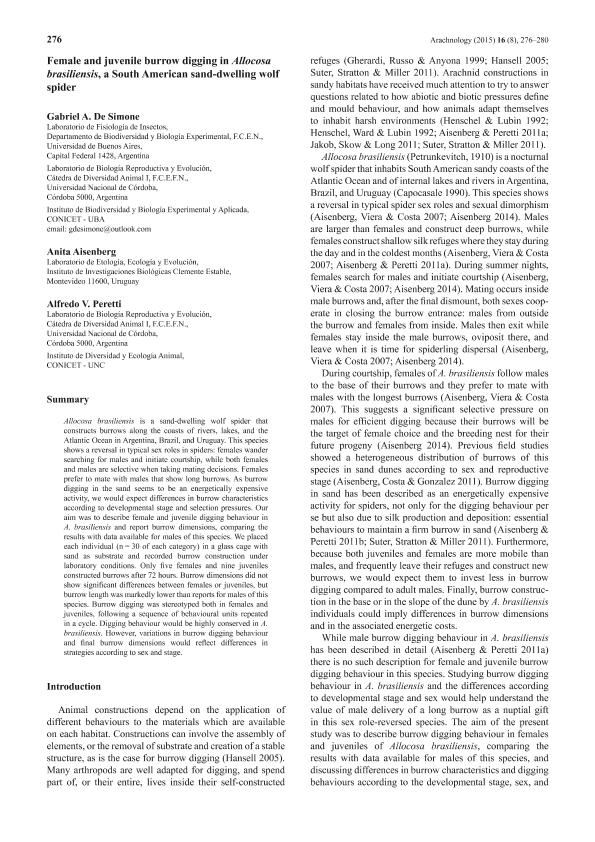Mostrar el registro sencillo del ítem
dc.contributor.author
de Simone, Gabriel Alejandro

dc.contributor.author
Aisenberg, Anita Diana
dc.contributor.author
Peretti, Alfredo Vicente

dc.date.available
2016-11-07T18:09:27Z
dc.date.issued
2015-02
dc.identifier.citation
de Simone, Gabriel Alejandro; Aisenberg, Anita Diana; Peretti, Alfredo Vicente; Female and juvenile burrow-digging in Allocosa brasiliensis, a South American sand-dwelling wolf spider; British Arachnological Society; Arachnology; 16; 8; 2-2015; 276-280
dc.identifier.issn
2050-9928
dc.identifier.uri
http://hdl.handle.net/11336/8028
dc.description.abstract
Allocosa brasiliensis is a sand-dwelling wolf spider that constructs burrows along the coasts of rivers, lakes and the Atlantic Ocean in Argentina, Brazil and Uruguay. This species shows a reversal in typical sex roles in spiders: females wander searching for males and initiate courtship, while both females and males are selective when taking mating decisions. Females prefer to mate with males that show long burrows. As burrow digging in the sand seems to be an energetically expensive activity, we would expect differences in burrow characteristics according to developmental stage and selection pressures. Our aim was to describe female and juvenile digging behavior in A. brasiliensis and report burrow dimensions, comparing the results with data available for males of this species. We placed each individual (n = 30 of each category) in glass cages with sand as substrate and recorded burrow construction under laboratory conditions. Only five females and nine juveniles constructed burrows after 72 hours. Burrow dimensions did not show significant differences between females or juveniles, but burrow length was markedly lower that reports for males of this species. Burrow digging was stereotyped both in females and juveniles, following a sequence of behavioral units repeated in a cycle. Digging behavior would be highly conserved in A. brasiliensis. However, variations in burrow digging behavior and final burrow dimensions would reflect differences in strategies according to sex and stage.
dc.format
application/pdf
dc.language.iso
eng
dc.publisher
British Arachnological Society
dc.rights
info:eu-repo/semantics/openAccess
dc.rights.uri
https://creativecommons.org/licenses/by-nc-sa/2.5/ar/
dc.subject
Animal Behaviour
dc.subject
Animal Construction
dc.subject
Burrow Diggin
dc.subject
Wolf Spider
dc.subject.classification
Zoología, Ornitología, Entomología, Etología

dc.subject.classification
Ciencias Biológicas

dc.subject.classification
CIENCIAS NATURALES Y EXACTAS

dc.title
Female and juvenile burrow-digging in Allocosa brasiliensis, a South American sand-dwelling wolf spider
dc.type
info:eu-repo/semantics/article
dc.type
info:ar-repo/semantics/artículo
dc.type
info:eu-repo/semantics/publishedVersion
dc.date.updated
2016-11-03T19:16:45Z
dc.journal.volume
16
dc.journal.number
8
dc.journal.pagination
276-280
dc.journal.pais
Reino Unido

dc.journal.ciudad
Londres
dc.description.fil
Fil: de Simone, Gabriel Alejandro. Universidad de Buenos Aires. Facultad de Ciencias Exactas y Naturales. Departamento de Biodiversidad y Biología Experimental; Argentina. Consejo Nacional de Investigaciones Cientificas y Tecnicas. Oficina de Coordinacion Administrativa Ciudad Universitaria. Instituto de Biodiversidad y Biologia Experimental y Aplicada; Argentina
dc.description.fil
Fil: Aisenberg, Anita Diana. Inst. Investigaciones Biológicas Clemente Estable;
dc.description.fil
Fil: Peretti, Alfredo Vicente. Consejo Nacional de Investigaciones Cientificas y Tecnicas. Centro Cientifico Tecnologico Cordoba. Instituto de Diversidad y Ecologia Animal; Argentina
dc.journal.title
Arachnology
dc.relation.alternativeid
info:eu-repo/semantics/altIdentifier/url/http://www.bioone.org/doi/abs/10.13156/arac.2015.16.8.276
dc.relation.alternativeid
info:eu-repo/semantics/altIdentifier/url/http://dx.doi.org/10.13156/arac.2015.16.8.276
Archivos asociados
